FORT MEADE, Md. — The Army has initiated many changes to help modernize the service, bolster readiness, and increase lethality.
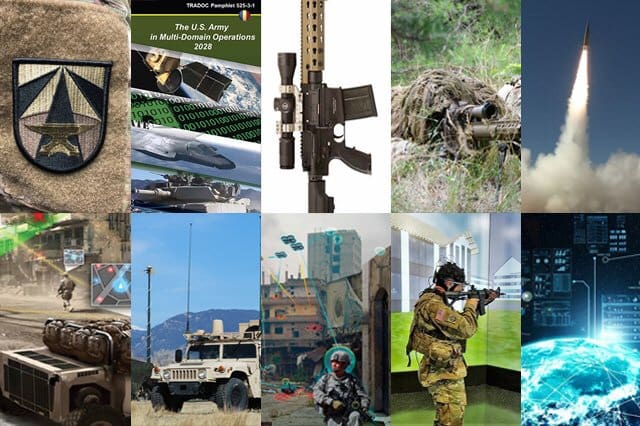
Below is a list of some of the biggest modernization stories that impacted the force in 2018. (Links to the original stories follow this article.)
FUTURES COMMAND FINDS HOME
In July, senior leaders announced that Austin, Texas would be the new home for Army Futures Command.
Selected from about 150 competing locations, Austin offered a growing community of professionals within the science and tech industries. Further, the city hosted academic institutions with thousands of graduates in science, technology, engineering, and mathematics fields.
Back in October 2017, the Army announced its intent to create a new command to drive the service’s modernization efforts. Army Futures Command was heralded as one of the most significant Army reorganization efforts since 1973.
In August, Army senior leaders converged in Austin to unveil AFC’s new headquarters in the University of Texas System building.
During the assumption of command ceremony, Chief of Staff of the Army Gen. Mark A. Milley unfurled and presented the Army Futures Command flag to Gen. Mike Murray, the newly-appointed AFC commander.
Closing out the year, AFC unveiled its new “golden anvil” shoulder sleeve insignia and distinctive unit insignia, harkening back to former Gen. Dwight D. Eisenhower’s personal coat of arms.
MULTI-DOMAIN BATTLE
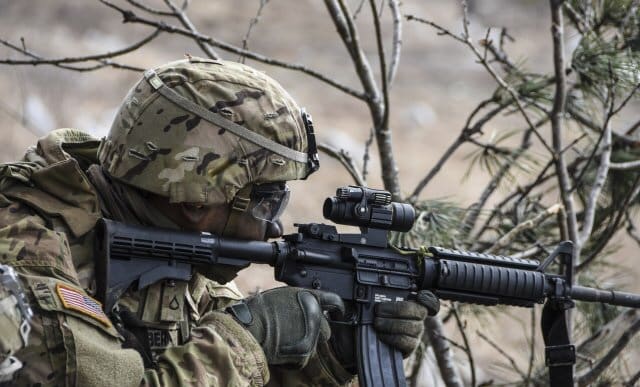
Army leaders recently released “The U.S. Army in Multi-Domain Operations 2028,” which outlines possible solutions to counter and defeat layers of stand-off created by adversaries.
Referred to as MDO Concept 1.5, the new pamphlet published by U.S. Training and Doctrine Command refines the force’s Multi-Domain Battle concept released last year.
The concept asserts that over the years adversaries have studied how the U.S. military operates. Emerging technologies — such as artificial intelligence, hypersonics, machine learning, nanotechnology, and robotics — have also changed the character of war.
The release of TRADOC Pamphlet 525-3-1 serves as a first step in the force’s doctrinal evolution, officials said.
MARKSMAN RIFLE & NIGHT BINOCULAR
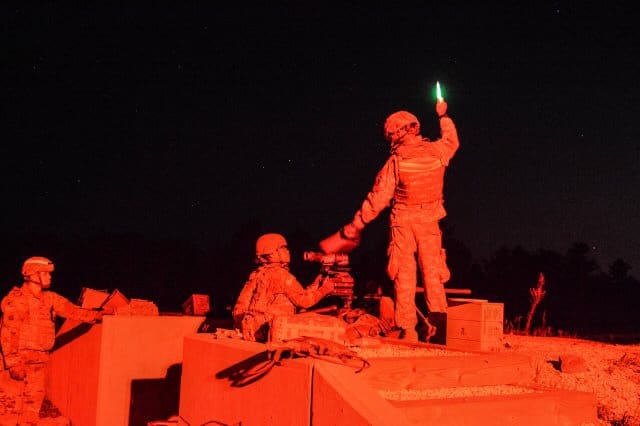
This fall, the Army began fielding the new Squad Designated Marksman Rifle to the first selected units. A limited-user test of the SDM-R is also underway now at Fort Bliss, Texas.
The rifle is based on the Heckler and Koch G28E-110 Compact Semi-Automatic Sniper System, or CSASS, and provides infantry, scout, and engineer squads the capability to engage with accurate rifle fire at longer ranges.
Additionally, this year the Army tested a new binocular with a wireless connection to rifle sites. The Enhanced Night Vision Goggle-Binocular, or ENVG-B, is scheduled for release to selected units sometime in fiscal year 2019.
The new device has both night vision and thermal-sensing capabilities and stereoscopic binocular depth perception, providing Soldiers with an illusion of depth on a flat image.
During testing, Soldiers had a 100 percent improvement in weapons qualifications, along with a 300 percent increase in detection of targets in day and night environments, and a 30 to 50 percent decrease in the time taken to shoot a target.
Soldiers that tested the new ENVG-B considered it to be “a game changer.”
IMPROVED GHILLIE SUIT
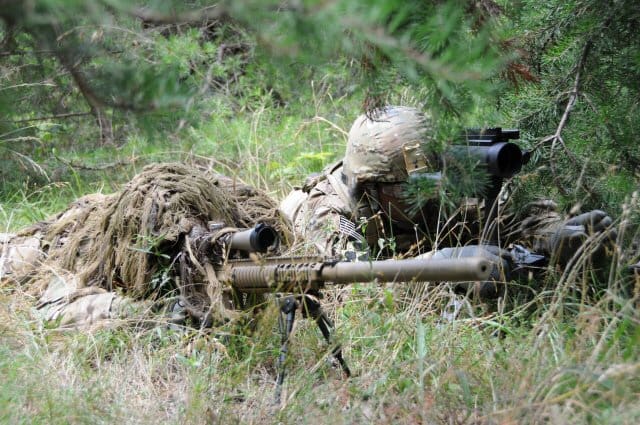
The Army is working to replace its current Flame Resistant Ghillie System, which Soldiers consider to be bulky and somewhat uncomfortable at higher temperatures.
The new Improved Ghillie System will be modular and may be worn over a Soldier’s field uniform. Soldiers should be able to take apart the IGS and use pieces as needed.
The goal is for the IGS to cost less than the current $1,300 FRGS, and still have flame-resistant properties.
HYPERSONICS
The Army is working to develop unique hypersonic weapons, similar to precision technology currently in development by the Air Force and Navy.
Hypersonic weapons move five times faster than the speed of sound and are designed to potentially deliver a precision-guided airstrike anywhere in the world within an hour.
While the Army establishes its hypersonic program office, representatives from the Army and other services will continue to work together to develop the military’s hypersonic weapons capability.
Currently, the joint team is working to create a standard “hypersonic glide body” to provide a means to deploy a hypersonic weapon.
IP MANAGEMENT POLICY
Secretary of the Army Mark T. Esper recently approved the new Intellectual Property Management Policy to support the force’s readiness and modernization efforts.
Before the new policy, the Army lacked a coordinated strategy to secure IP rights and fulfill its long-term sustainment goals. Previous examples of the acquisition process have shown that the Army often requests either too little, or too much IP.
The new policy attempts to kick off a cultural change within the Army and create a proactive approach to IP management and acquisition.
IMPROVEMENTS TO COMMAND POST TECHNOLOGY, MISSION COMMAND
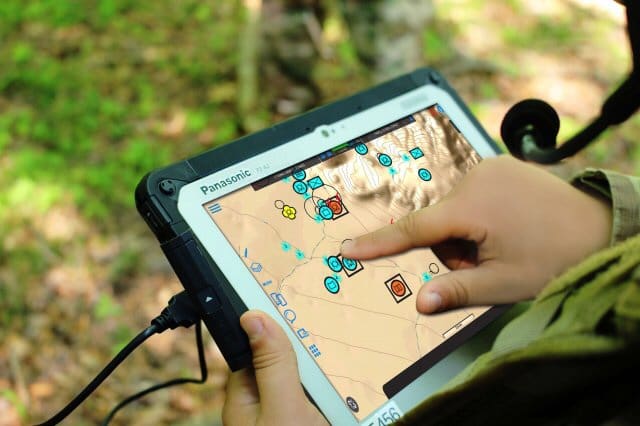
The U.S. Army Communications-Electronics Research, Development, and Engineering Center revealed 15 Soldier-vetted technologies this year designed to improve command post capabilities.
For the past three years, CERDEC’s expeditionary Mission Command Science and Technology Objective has worked to improve command post infrastructure.
Overall, the new technologies will make it quicker and easier for Soldiers to both setup and tear down a command post and will help improve command post connectivity, agility, and scalability.
ARTIFICIAL INTELLIGENCE
In the future, the Army could employ artificial intelligence to help process and simplify information, augment current or future systems, or enhance an operator or commander’s decision-making process.
Although the employment of artificial intelligence is still in its infancy, AI could aid Soldiers on the battlefield by providing leap-ahead technologies to help the force survive and win, according to Vice Chief of Staff of the Army Gen. James C. McConville.
For example, AI capabilities could control robotic loader and firing mechanisms or provide targeting recognition capabilities to support Soldiers in ground combat. Further, AI could help determine the best time to perform maintenance or replace parts.
Overall, AI is one of the Department of Defense’s top priorities. The development and implementation of AI will be a critical component of other DOD priorities such as hypersonic weapons, and autonomous ground and air unmanned systems.
NEUROSTIMULATION
The U.S. Army Natick Soldier Research, Development and Engineering Center has been experimenting with neurostimulation at the Center for Applied Brain and Cognitive Sciences in Medford, Massachusetts.
Volunteers in the program have shown an increase in ability or attention span, improved navigation performance, or enhanced motor skills when participating in a series of controlled tasks within a testing environment.
Further, Soldier participating in the program shortly after initial-entry training have shown signs of accelerated learning. This increase in learning has the potential of closing the gap between low and high performers on specific tasks.
NETWORK
Strengthening the Army’s network against increasing cyber threats, all while making it accessible across each level of the Army, has become a crucial point of emphasis for Army leaders.
With network modernization as a top priority, the Army has set initiatives to develop an integrated network to win battles in peer-contested environments and work toward joint coalition interoperability.
Moving forward, the Army plans to scale the integrated network to brigade-sized formations. The service will start fielding formations in 2020.
By Devon L. Suits, Army News Service


great stuff if the ENVG-B will trickle down to the regulær grynts
None of these programs or focus areas fall under Army Futures Command. While the article doesn’t explicitly claim that they do, it is inferred.
They’re trying hard to validate its use/need. All they did was take parts and people from Army Materiel Command and send them to Austin and call them AFC … now AMC and AFC will work on the same thing and clash on everything
Glancing over the article I read “Necrostimulation”, and I was like – wait..what?
….and hired retired, former senior leaders who had no interest in modernizing the units they were in charge of during the war. The logic will continue to escape me and my children’s children. The commander’s are in the best interest to move their communities forward, not Big Army. MIPR/MILSTRIP- FedMall, TLSP, and lastly GSA.
Speaking of futures, I hope that in the future that the PFC pictured will actually place the stock of his rifle in his shoulder and get his hand out on the hand guard.